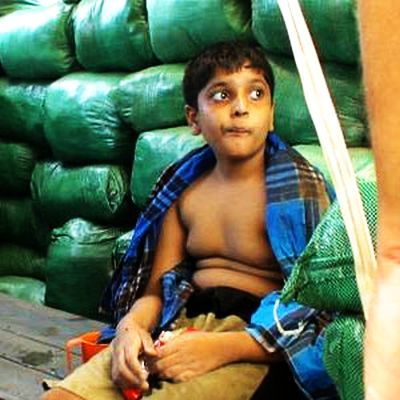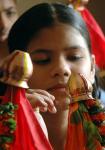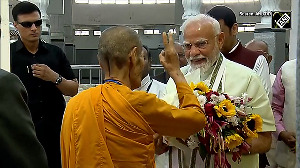 A recent inquiry report by the Geneva-headquartered Office of the High Commissioner for Human Rights has cast serious aspersions on the claims of the Sri Lankan government over alleged war crimes during the conflict with the LTTE. Vicky Nanjappa reports.
A recent inquiry report by the Geneva-headquartered Office of the High Commissioner for Human Rights has cast serious aspersions on the claims of the Sri Lankan government over alleged war crimes during the conflict with the LTTE. Vicky Nanjappa reports.
How was the son of Liberation Tigers of Tamil Eelam Chief V Prabhakaran killed? There have been conflicting views on the question and there is a claim that the 12-year-old Balachandran was not killed in a cross fire but was targeted by the Sri Lankan forces.
A report by the Office of the High Commissioner for Human Rights has slammed the Sri Lankan government and stated that the island nation’s authorities are yet to conclude the investigations into the various cases of extra judicial killings. The report will be submitted to the United Nations Human Rights Council.
“Despite the significant progress achieved in the physical aspects of resettlement and recovery, and the implementation of some of the recommendations made by the Lessons Learnt and Reconciliation Commission, the government of Sri Lanka has yet to satisfy the call made by the Human Rights Council for a credible and independent investigation into the allegations of serious human rights violations that persist or to take the necessary steps to fulfil its legal obligations to ensure justice and redress, “ the report also states.
The report states that the Sri Lankan government continues to maintain that the son of LTTE chief Velupillai Prabhakaran was killed in cross fire.
Whether Balachandran was killed in a cross fire or not had become a point of debate following a documentary by the Channel 4 last year. The documentary showed several pictures where Balachandran was sitting along with Sri Lankan forces and then his dead body was lying with bullet injuries.
Balachandran
In February 2013, a series of photographs emerged depicting Balachandran sitting in a bunker in the ‘custody’ of Sri Lankan troops, then his body lying on the ground, his chest pierced by bullets.
The photographs were taken in May 2009, a few hours apart and with the same camera. The Sri Lankan authorities have maintained that the boy was killed in cross-fire, the report states.
Thurairajasingham alias Colonel Ramesh:
Video and photographic material obtained by Channel 4 and other sources depict LTTE commander Colonel Ramesh being interrogated by Sri Lankan security forces, followed by still images of his mutilated dead body. According to several witness testimonies to the events surrounding the fate of Colonel Ramesh, he was in the custody of the security forces at the time of his death.
Shoba alias Isaipriya
The analysis by the Special Rapporteur on extrajudicial, summary or arbitrary executions of the Channel 4 photographic and video material of the death of a high-profile member of the LTTE press and communications wing, Isaipriya, revealed the likelihood of summary execution by the army. The video and pictures showed that her clothing had been pulled away to reveal her bare body.
In November 2013, Channel 4 released new footage that shows her being captured alive by the army.
“With regard to each of the above three cases, the government stated the authenticity of the footage and photographs remained unsubstantiated and unverified. Whether this has been the subject of any further investigation is unknown”, the report states.
The report states that it is important for the Human Rights Council to recall the magnitude and gravity of the violations alleged to have been committed by the government and the LTTE, which left many thousands of civilians killed, injured or missing. In its report, the Secretary-General’s Panel of Experts concluded that, if proven, some of these acts would amount to war crimes and crimes against humanity.
The report further states that the government has launched initiatives and established mechanisms, such as the military courts of inquiry and the Commission of Inquiry on Disappearances, but none of these have the independence to be effective or to inspire confidence among victims and witnesses.
The military courts of inquiry lack independence and transparency and are limited in scope. Past commissions of inquiry have not always completed their mandate, their reports have not been published and their recommendations have not been implemented or followed by prosecutions, the report adds.
The Human Rights Commission of Sri Lanka, although handling many routine cases, has a poor record in responding credibly to serious violations committed by the military and security forces. For the past several years, Sri Lankan courts have been compromised by politicisation and interference by the executive, the report points out.
Cases or presiding magistrates and judges are often transferred from one court to other, thereby delaying judicial proceedings. The high commissioner heard from lawyers about large numbers of fundamental rights applications, including in cases of arbitrary detention and torture, that are discouraged or not given leave to proceed by the Supreme Court.
“One consequence of this situation is the understandable reluctance of victims and witnesses to come forward in the absence of any effective system for their protection. In many cases, witnesses have been intimidated to discourage their giving testimony, and even killed. This has been a major constraint on criminal investigations, as well as on the work of previous commissions of inquiry and the Lessons Learnt and Reconciliation Commission. The attorney-general himself informed the high commissioner that the reluctance of witnesses to come forward was the main reason for the lack of progress in such emblematic cases as the ones concerning Trincomalee and Action contre la Faima bill on assistance and protection for victims of crime has been in preparation since 2007, and was tabled in Parliament in June 2008,” the report notes.
“The previous drafts contained many provisions that were not compliant with international human rights law. Although the Supreme Court recommended several amendments, it is not clear whether they were incorporated. According to the government, the legislation is being finalised, even though the final version has yet to be released for public consultation.
“At the same time, new evidence -- including witness testimony, video and photographic material -- continues to emerge on the events that took place in the final stages of the armed conflict. Human remains are also still being discovered, for instance in Matale, in November 2012, and Mannar, in December 2013.
“As the emblematic cases highlighted above show, national mechanisms have consistently failed to establish the truth and achieve justice. The high commissioner believes this can no longer be explained as a function of time or technical capacity, but that it is fundamentally a question of political will. The Secretary-General’s Panel of Experts and the initiatives taken by international non-governmental organisations have shown that witnesses are willing to come forward to testify to international inquiry mechanisms that they trust and can guarantee their protection. For this reason, the high commissioner remains convinced that an independent, international inquiry would play a positive role in eliciting new information and establishing the truth where domestic inquiry mechanisms have failed. In the absence of a credible national process, she believes the international community has a duty to take further steps, which will advance the right to truth for all in Sri Lanka and create further opportunities for justice, accountability and redress”, the report says.
The high commissioner recommends that the Human Rights Council establish an international inquiry mechanism to further investigate the alleged violations of international human rights and humanitarian law and monitor any domestic accountability processes. OHCHR stands ready to assist in such a process, then report notes.
The high commissioner recommends that the government of Sri Lanka:
- Finalise laws dealing with incitement to hatred, witness and victim protection, the right to information and the criminalisation of enforced disappearances, and revise existing laws in accordance with international standards;
- Repeal the Prevention of Terrorism Act and lift the regulations promulgated under it that allow for arbitrary detention;
- Arrest, prosecute and punish perpetrators of attacks on minority communities, media and human rights defenders, and ensure protection of victims;
- Undertake independent and credible criminal and forensic investigations with international assistance into all alleged violations of human rights and humanitarian law, including recently discovered mass graves;
- Establish a truth-seeking mechanism and national reparations policy in accordance with international standards as an integral part of a more comprehensive and inclusive approach to transitional justice;
- Broaden the scope and tenure of the Commission of Inquiry on Disappearances to encompass cases from all parts of the island and all periods of the history of disappearances;
- Publish the final report of the military courts of inquiry, the presidential commission of inquiry of 2006 and the more recent commissions of inquiry to allow the evidence gathered to be evaluated;
- Take further steps in demilitarisation, ensure military disengagement from activities that are meant to be civilian, resolve land disputes and promote meaningful community participation in reconstruction and development;
- Engage civil society and minority community representatives more fully in an inclusive and consultative process to support the implementation of the recommendations made by the Lessons Learnt and Reconciliation Commission.
Image: A video grab shows Balachandran in a military bunker, moments before he was killed.










 © 2025
© 2025